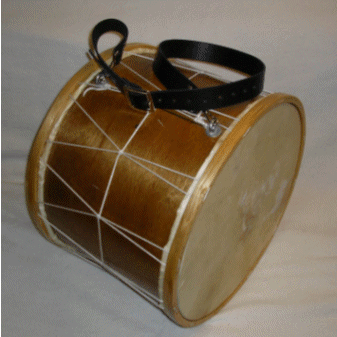
This is the homepage of Tupans etc. which discusses the Tupans, Tupan sticks and Gadulka tuning wrenches which I make. I also mount Gajda blowpipe valves and have included a writeup about how to tie-in Gajda bags because I figured other people didn't need to make all the same mistakes I did.
So what is a Tupan (or Tapan or Daoul or Daouli or Davul)? A Tupan is a two headed drum used throughout the Balkans, Greece, Turkey, North Africa, across the Arab lands all the way to India and China. It is probably the ancestor of the modern marching band bass drum, as the Turkish armies that nearly conquered Europe played them, and the Turkish military band was one of the major roots of modern marching bands. The diameter and depth (thickness) vary greatly, as do the head and shell materials. The drums I make have laminated wooden shells and goat skin heads, but there are lots of other possibilities. Shells are usually wood (either bent or laminated) but I've seen metal, plastic pipe, and even heavy cardboard used. For heads I've seen goat, calf, deer and antelope skin, and various plastics, including drafting mylar which still had drawings on it. Usually there is one thick and one thin head which yield a low and a high note respectively, when struck. A good Tupan player can sound like an entire trap set. In the Balkans, Greece, and Turkey, the drum is usually suspended from one shoulder and played with a heavy stick or mallet striking the heavy head and a light switch striking the light head, giving a "boom, tek" sound. Often the heavy head is damped to make the "boom" even deeper. But again, there are lots of other options.
The main use of Tupans is as the supporting rhythm under dance or processional music. The melody instruments wander all over the place but the drum is what the people are really dancing / walking to. As a melody instrument player (bagpipe), I know that a good Tupan player is a joy and a bad one is a curse. If you plan to play tupan, focus on rhythm and keep us melody instruments honest.
